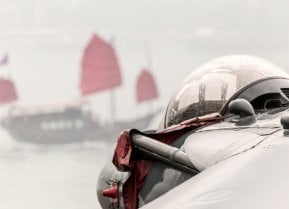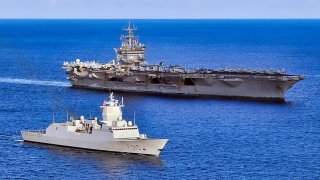USS Enterprise: This Might Be America's Best Aircraft Carrier Ever
The name Enterprise has a storied history in the U.S. Navy, with eight vessels bearing the name and a ninth, CVN-80, currently under construction.
Summary and Key Points: The name Enterprise has a storied history in the U.S. Navy, with eight vessels bearing the name and a ninth, CVN-80, currently under construction.

-Notably, CVN-65, the first nuclear-powered aircraft carrier, served from 1961 to 2012, participating in numerous conflicts and surviving significant incidents, including a major fire in 1969. The upcoming CVN-80, part of the Ford-class carriers, represents an evolution in naval technology, featuring advancements like the Electromagnetic Aircraft Launch System.
-However, construction delays have pushed its expected delivery to late 2029. Despite these setbacks, the legacy of the USS Enterprise continues to be an integral part of U.S. naval history.
The Storied History of the USS Enterprise in the U.S. Navy
The name Enterprise carries quite a bit of history in the U.S. Navy. Eight different vessels have borne the name, with a ninth currently planned. When combined, the vessels’ lives span virtually the whole history of the U.S. Navy.
Perhaps the most well-known Enterprise is CVN-65, the first nuclear-powered aircraft carrier. From 1961 to 2012, she participated in multiple conflicts and marked a number of historic events. A major flight deck fire in 1969 helped prove firefighting concepts learned from the Navy’s Forrestal fire.
In 2012, CVN-65 was decommissioned. At its very decommissioning ceremony, the secretary of the Navy announced the name Enterprise would live on in the third Gerald Ford-class carrier, which is currently under construction.
Big E History
The first Enterprise in Navy lineage did not even belong to the Navy. Rather, it was a British ship captured on Lake Champlain by the Continental Army and burned two years later to prevent the British from reclaiming her. Likewise, the second Enterprise was a privateer purchased for the Continental Navy. Little is known of her service record before she was returned to the Maryland Council of Safety in 1777.
Only in 1799 was the first USS Enterprise launched explicitly for the U.S. Navy. She participated in the Barbary War and served for over 20 more years until she ran aground and broke up in the Caribbean in 1823.
Two more sailing vessels bore the name Enterprise through the 19th century, with little of note to their careers. During the First World War, the Navy purchased a wooden motor yacht called Enterprise from a private citizen to serve as a patrol craft.
The commissioning of USS Enterprise CV-6 in 1938 is where the “Big E” really came into her own. One of only three carriers built pre-war that survived the entire Second World War, this Enterprise participated in nearly every major engagement in the Pacific and survived significant damage. Her legacy was carried on by CVN-65.
Design and Operational History
While she wasn’t the first supercarrier, CVN-65 was one of the largest. At 1,122 feet long and displacing 94,781 tons, she is the longest warship ever built, and the third-largest by displacement. Her unique design includes eight reactors – far more than the two now standard – as well as four rudders, double every other carrier.

Over the course of her career, she achieved many major milestones, such as the first aircraft launch with a launch bar as opposed to a catapult bridle. She logged multiple combat deployments to Vietnam, launching thousands of strikes against targets.
The Fire
In 1969, as Enterprise prepared for another deployment to Vietnam, she stopped in Hawaii for a last Operational Readiness Inspection.
During flight deck operations, an MD-3A “Huffer” – a tractor-mounted power unit used to start aircraft – was positioned such that its exhaust was blowing directly on a Zuni rocket mounted to an F-4 Phantom at the stern of the ship. At 8:18, the rocket became so hot it detonated, blowing holes in the Phantom’s fuel tanks and igniting the fuel inside. The resulting inferno would spark over a dozen more explosions from various bombs and fuel storage units. These blasts blew eight holes in the flight deck, allowing burning fuel to spill onto the decks below.
In contrast to the Forrestal fire, where just over half the crew had attended firefighting training, 96% of Enterprise’s crew, and 86% of the embarked air wing, had received the training. A later investigation concluded that despite the massive damage and tragic toll of the fire – 28 sailors lost their lives – the actions of the crew were instrumental in containing the effects of the blaze. After the fire, Enterprise put in at Pearl Harbor for repairs before continuing her deployment to Vietnam. She served for many more decades and participated in Operations Enduring Freedom and Iraqi Freedom. She was decommissioned in 2012.
Introducing the New Big E
The decommissioning of CVN-65 was not the end of USS Enterprise. CVN-80, the third Ford-class carrier, will bear the name Enterprise and carry on the legacy of these ships in the Navy. Naming this carrier Enterprise will break a streak of naming supercarriers after individuals that dates back to the 1960s.
Delays for the New USS Enterprise
CVN-80 will be a Ford-class carrier, an evolution from the Nimitz class that currently makes up the bulk of the U.S. carrier fleet. Technological improvements allow the Fords to sail with several hundred fewer crewmembers. Additionally, they mount an Electromagnetic Aircraft Launch System to replace the steam catapults in use since the 1950s.
The upcoming USS Enterprise (CVN-80) has fallen victim to delays. Initially, the service expected to receive the warship in 2028, but supply chain issues and other resource shortages have pushed this timeline back to late 2029.
“Any deviation that lengthens intervals between platforms compared to previously approved shipbuilding plans and forecasts is concerning because of the potential disruption to our supplier base, which continues its recovery amid significant levels of demand for its materials and products,” Todd Corillo, a spokesperson for HII’s Newport News Shipbuilding, said in a statement about the construction delays.
About the Author: Maya Carlin
Maya Carlin, National Security Writer with The National Interest, is an analyst with the Center for Security Policy and a former Anna Sobol Levy Fellow at IDC Herzliya in Israel. She has by-lines in many publications, including The National Interest, Jerusalem Post, and Times of Israel. You can follow her on Twitter: @MayaCarlin.
All images are Creative Commons.


